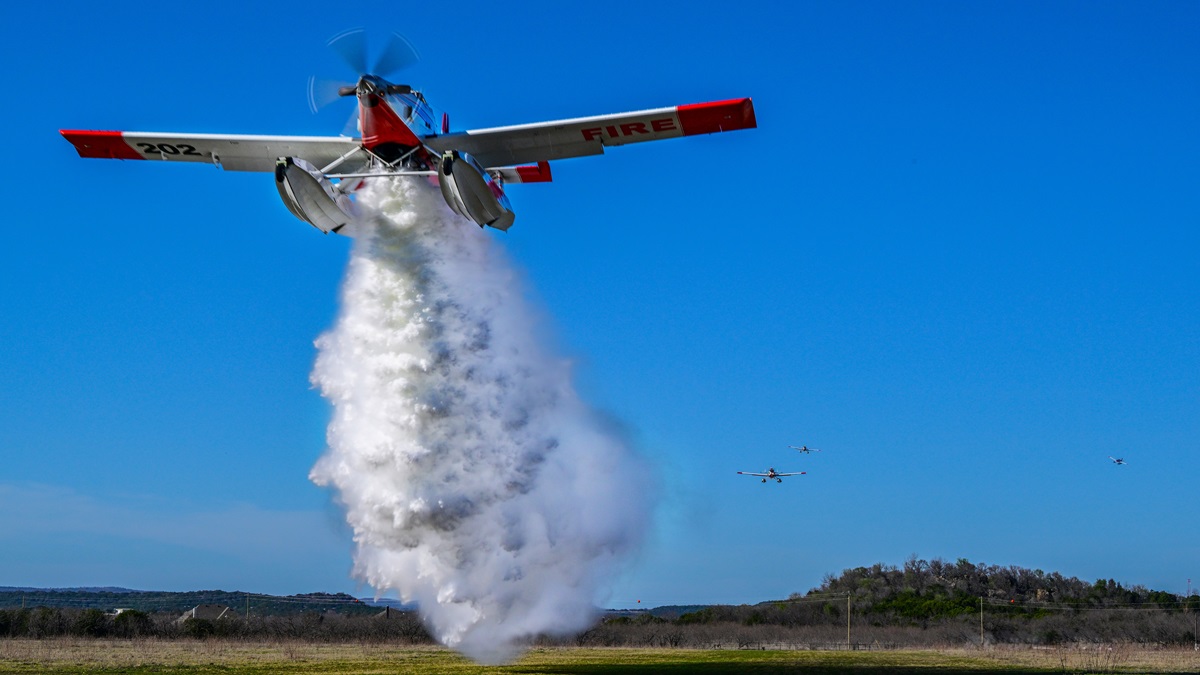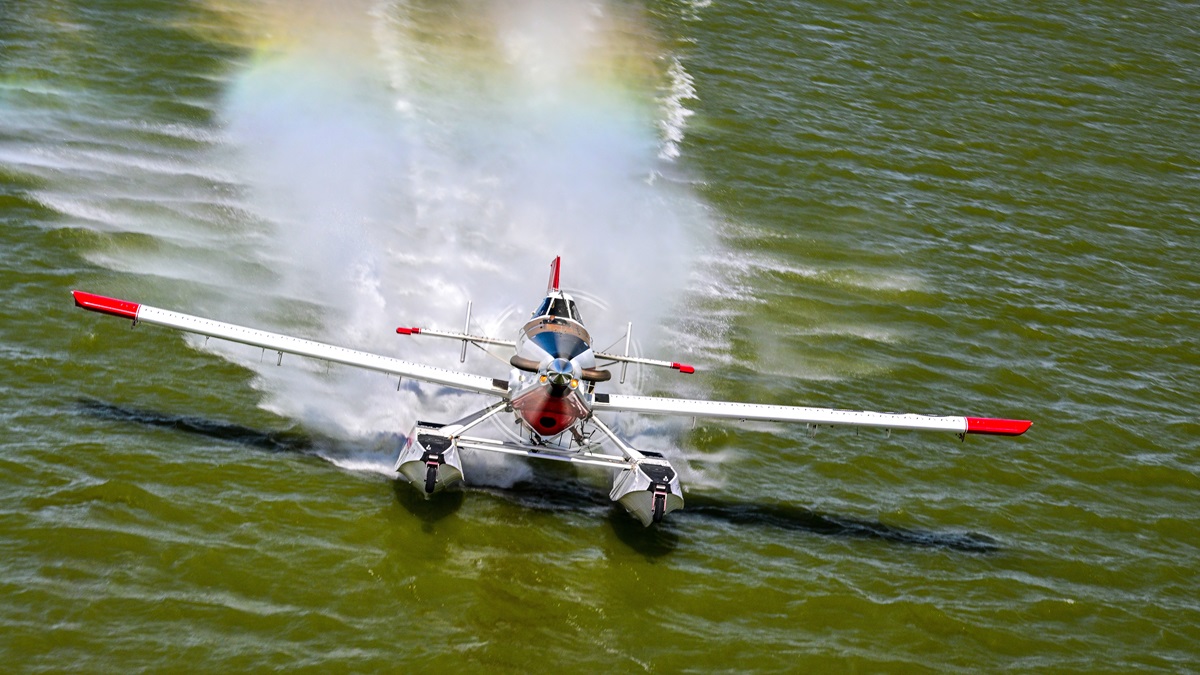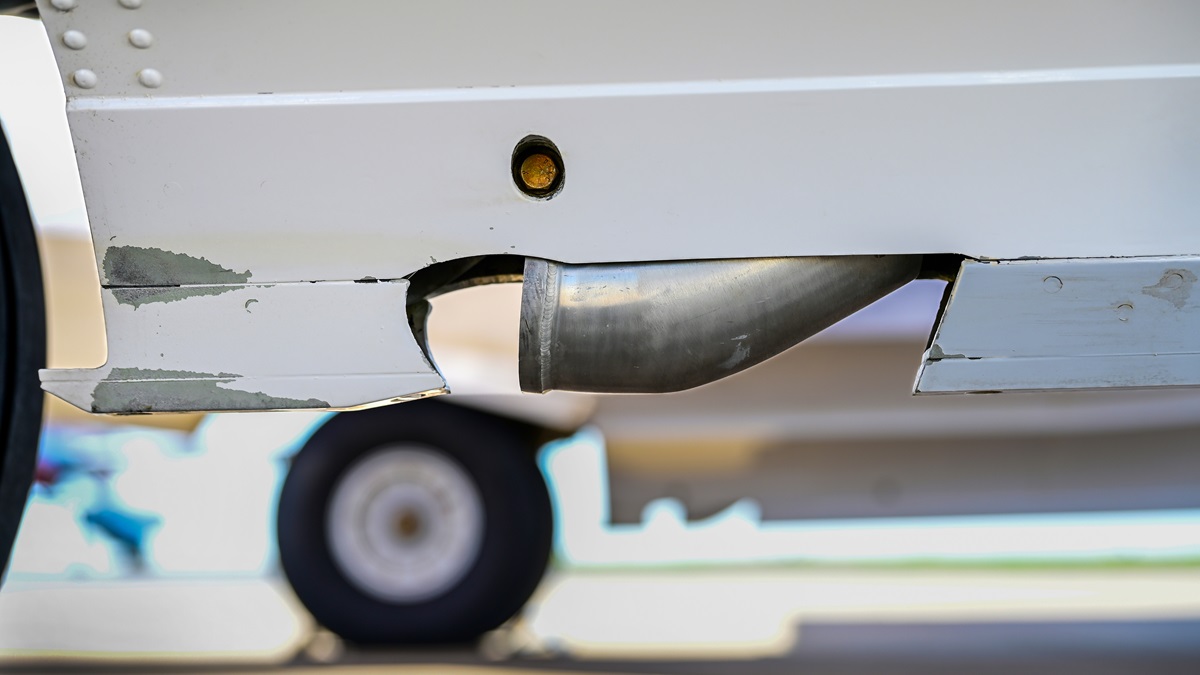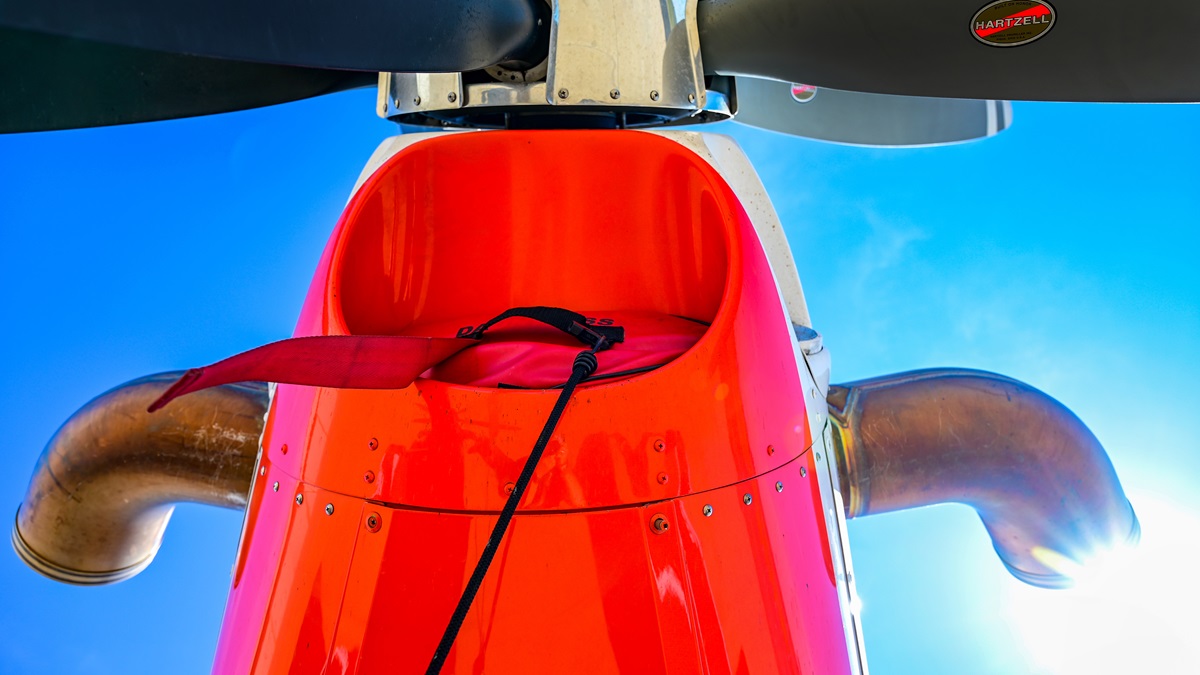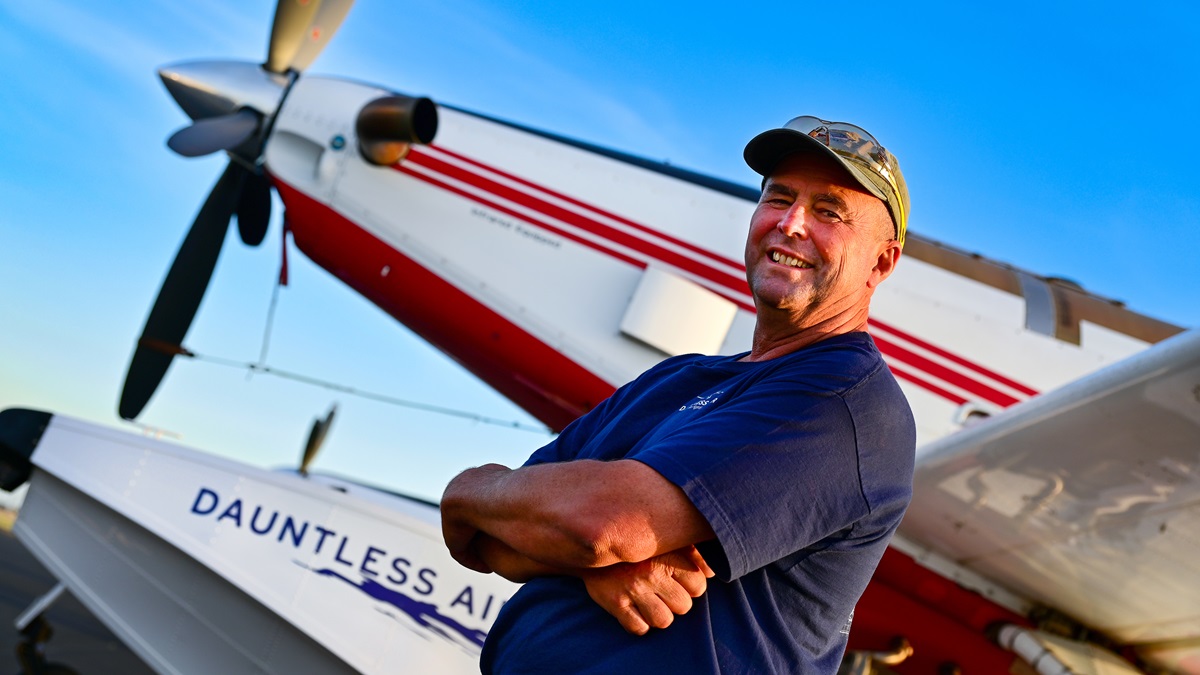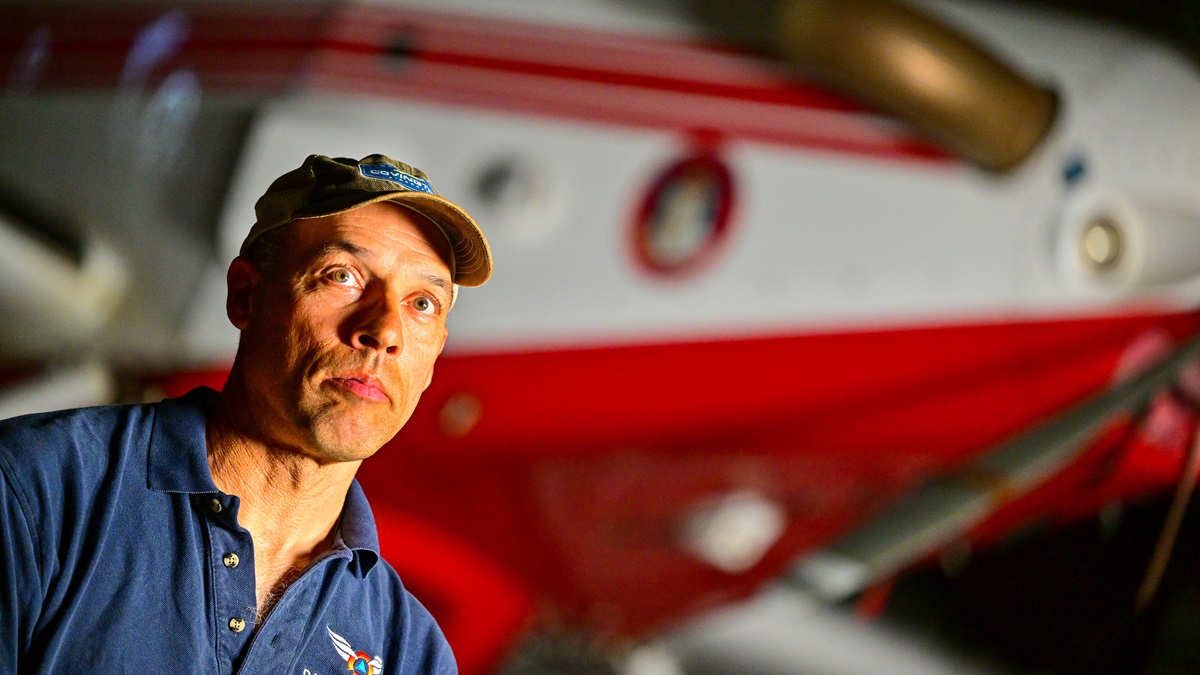When the heat is on
Dauntless Air Fire Boss operations
In the lead aircraft we gain visual on the scene and call the attack plan. Our wing pilot, Steve Helinski, echoes our call, confirming aircraft systems are armed for a live drop. Seconds matter. Precision can mean life or death. We fly overhead and release our load—shack—direct hit. Our wing pilot, in staggered trail, follows with his drop seconds later. We’ve stunned the enemy and bought friendly fighters time, but it won’t be enough. We climb and bank hard to set up for another pass.
The “enemy” in our mock scenario is a strand of trees on a small island in the middle of Lake Whitney, simulating a wildfire that changed behavior and caught a team of Hot Shots—elite wildfire fighters—off guard. I’m in Cleburne, Texas, flying with Dauntless Air during their annual 10-day training session preparing pilots for the upcoming wildfire season.
Dauntless Air, based in Appleton, Minnesota, deploys 17 Air Tractor 802s to hot spots throughout the continental United States and Alaska during wildfire season. Wipaire Wipline 10000 amphibious floats, a 1,600-horsepower Pratt and Whitney PT6A-67F turbine engine (the most powerful PT6 variant), and a five-blade Hartzell propeller transform the Air Tractor into Dauntless Air’s intimidating “Fire Boss.” The Fire Boss tops 16,000 pounds maximum gross weight, almost 6,700 of which can be water held in an 800 gallon “hopper” tank forward of the pilot.
Wipaire designed the custom floats with a 2.6-inch-diameter probe on each that rotates down into the water. Pressure from forward speed while step-taxiing at 65 knots forces water through the probes and up tubes that run along the float struts and into the hopper. In ideal conditions—up to two-foot waves and 15 knots of headwind—the Fire Boss “scoops” 800 gallons of water in less than 15 seconds, then climbs out at 500 fpm. Dauntless Air pilots must balance the Fire Boss chopping through wave tops while adding 42 percent of its gross weight sloshing into the hopper at more than 440 pounds per second. Displacement from the Wipline 10000s can’t support the Fire Boss at gross weight, so any problem that degrades airspeed or impairs flying off the water requires a rapid dump, or the aircraft will sink. On glassy water—worst-case performance for any floatplane—the Fire Boss requires 5,000 feet for approach, “scoop,” and climbout over a 50-foot obstacle.
Dropping the water is no less astonishing. Typical drop altitude is 60 feet above the ground or treetops. Pilots run inbound at 110 knots and “pickle” (drop) the payload, which can be water, a water-gel mix, or fire retardant. Fire Boss pilots can modulate the drop rate over a few seconds via a setting in the cockpit. At its limit, the entire 6,700-pound load is released in a second and a half. Pilots must anticipate the severe shift in weight and balance by pushing full forward stick simultaneously to the drop, or the aircraft will pitch up aggressively and could stall. Put yourself in the cockpit for that action: Inbound at 60 feet agl, 110 knots, and a 1,600-horsepower turbine engine close to full power, you push full forward on the stick as you simultaneously release a 6,700-pound payload. The Fire Boss keeps a steady altitude with this stick movement, although the tail rises slightly until the pilot stabilizes and trims. The entire operation is extraordinary on every level.
Pilots who fly the Fire Boss are no less impressive. If corporate jet pilots are the “bougie” slice of general aviation, roaming polished FBOs in ties and epaulets, Fire Boss pilots are the operatives in Carhartt jackets and Red Wing boots on the self-serve ramp. They offer no elaboration, only an accepting nod, when you marvel at their remarkable skill and courage.
Dauntless Air manages this cadre carefully. Stringent experience requirements are only the start: 1,500 hours minimum, 200 in mountain areas, 100 in seaplanes, and 200 low-level flight hours, 100 of which must be in Part 137 agricultural operations. No one has just the minimum. The most junior pilot I met, Scott Palmer from Idaho, had more than 2,200 hours. Pilots must also be willing to deploy during wildfire season on short notice throughout the Continental United States and Alaska for weeks at a time and fly steadily with only two days off every 14 days. Skill, availability, and durability aren’t all. The more difficult hurdle for Dauntless Air is to match the cultural dynamic. Fire Boss pilots are part of a complex and integrated wildfire fighting ecosystem. Understanding the mission, managing risk appropriately, blending in with the cadre of pilots, maintainers, and other wildfire response professionals is critical to mission and business success.
Simply flying the Fire Boss, outside of the mission arena, is surprisingly—well—easy. It looks huge and clunky on giant amphibious floats, but it’s a stick-and-rudder airplane and responds honestly. It needs some active rudder early in a turn to stay coordinated, and without flaps the nose tracks slowly in a turn, but add flaps and the turn rate picks up impressively. In the hands of a master, like Dauntless Director of Operations and Chief Pilot Jesse Weaver, the Fire Boss even feels agile. Weaver uses all the tricks to eke performance and smoothness: unloaded accelerations, slips, aggressive banks and G-moderation to get exactly where he wants at the speed he needs. It’s a joy to watch any pilot in the airplane they’ve mastered, and Weaver is there.
On the water, the Fire Boss is just a big floatplane. Approach speed with lift flaps is 100 knots. At about 50 feet, last glance at the airspeed indicator reveals about 80 knots, then eyes entirely outside, while steadily increasing pitch, use peripheral vision and feel the touchdown at about 65 knots, then power up and push stick slightly forward for the step taxi. Accelerate, roll a float up like any other floatplane, and the Fire Boss jumps off the water when the hopper is empty.
Flying the Fire Boss in the mission profile for which it’s designed is—well—not easy. Deploying probes to “scoop” water changes drag on the floats, and balancing the airplane during a massive weight and balance change requires a deft feel and constant stick adjustment. Fifteen seconds feels like a long time, especially jostling atop choppy waves. Weaver, with thousands of scoops, makes it look and feel easy.
“Your turn,” Weaver commands, and gives me the airplane. After settling on the water and deploying the probes I worry too much about cooking the PT6 engine and don’t add enough power, a pilot-induced oscillation begins as we rapidly upload water that sloshes back and forth in the hopper. I attempt to dampen the pilot-induced oscillation by steady backstick but continue bringing the stick too far aft. We begin to bog down and Weaver has had enough.
“Dump and power up. Let’s go,” he says. I power up while pushing the dump switch, which releases the water from the hopper, retracts the probes, and the Fire Boss jumps off the water like a captive lunging for freedom. Weaver soothes my ego by telling me, “Typical first attempt. It takes 10 hours to teach a seasoned seaplane pilot to scoop safely, and dozens more for them to learn to scoop smoothly.”
After gaining competence in single-pilot scooping, pilots move to the complexities of working an active wildfire. Fire Bosses often employ in four-airplane formations, flying trail in limited visibility amid mountain, wind, and thermal turbulence. They monitor up to six radios, while adhering to strict altitude limits for vertical deconfliction. Fire Bosses own the low ground along with rotary assets, and larger water-droppers stack above them. At the top of the stack is the “Air Attack,” who commands all air assets, often from the right seat of a Beechcraft King Air or similar aircraft. The Air Attack operates under direction of an overall wildfire incident commander on the ground. Incident commanders love the Fire Boss’ quick response and surgical application. Forward looking infrared (FLIR) and a head-up display (HUD) add to the Fire Boss’ effectiveness by helping Dauntless pilots target hot spots through the smoke. With a lake or river nearby, a single Fire Boss can make over 30 precise drops during a 3.5 hour fuel cycle, which makes the Fire Boss effective and efficient. With a nearby water source, costs run below a dollar per gallon of water deployed.
Dauntless Air flies a challenging mission, always in demanding conditions with added risk elements like seaplane operations, formation, mountain flying in limited visibility, low altitude, and life-or-death mission pressure. They’ve suffered no fatalities or serious injuries in 16 years of operating the Fire Boss. They’ve damaged three airplanes—one totally destroyed, the other two repaired and put back in service. CEO Brett L’Esperance describes their safety culture as “built on a foundation of experienced and trained pilots flying reliable equipment.” Richard Simpson, a former Air Tractor employee and one of the most respected experts in the industry, leads an in-house maintenance team that keeps the Dauntless fleet at an impressive 99.5-percent uptime availability. Company executives walk the talk and infuse the culture with investments in training and aircraft upgrades that push the operation ever safer, and more effective.
Wildfires are intense, and the conditions are intimidating. Fortunately, the pilots who fight them are by their nature and their training…dauntless.

